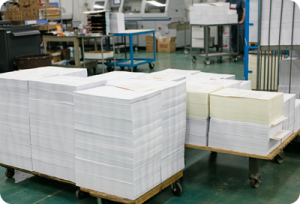Paper Types
Paper Types
Paper Types
Choosing the Right Paper Types for Your Book Printing
 What paper types are best for the interior pages of my book? We get this question quite a bit, and there is no right or wrong answer to this question. The choice of paper stock is completely up to you. In this article, we will explain the different types of paper that are used in the book publishing industry, and the stocks offered by DiggyPOD. To see and feel book paper stocks we offer, please order our Free Sample Book.
What paper types are best for the interior pages of my book? We get this question quite a bit, and there is no right or wrong answer to this question. The choice of paper stock is completely up to you. In this article, we will explain the different types of paper that are used in the book publishing industry, and the stocks offered by DiggyPOD. To see and feel book paper stocks we offer, please order our Free Sample Book.
Different Paper Types offered by DiggyPOD
At DiggyPOD, we only use the best publishing paper for your book. All the types of paper we use are acid free (acid free helps the paper from yellowing over time). Each paper type we use has an FSC Chain of Custody Certification. Listed below are the paper stocks we use:
- 50# White Smooth Offset
- 60# White Smooth Offset
- 60# Natural Smooth Offset
- 70# White Smooth Offset
- 80# White Gloss Text
What Type of Paper are Books Printed on?
Most printed books, use uncoated paper stocks for the inside pages of the book, and a coated cover stock for the book cover. Uncoated stocks come in different finishes and paper weights. Uncoated paper comes in two different finishes, either a vellum or smooth finish.
The uncoated smooth finish, is exactly that, a very smooth feel that helps keep the printing of text and photos very sharp. The vellum finish does appear to be smooth to the naked eye, but when you look closely you can see little paper fibers sticking up from the sheet. Printed images and text will not look as good on vellum compared to smooth stock, as the little fiber that stick-up can make the type and photos not as crisp as the smooth finish.
Coated stocks have a clay coating that is added during the paper making process, the coating usually is a matte, silk, or gloss finish. This coating does not allow the ink to absorb into the paper, but rather sit on top of the clay coating. Since the clay coating is on top of the paper fibers, the text and photos loose very little definition and will look much brighter and more defined.
When printing a book in full color or black and white, there will be a big difference on how the ink will look on an uncoated stock compared to a coated stock. With coated stocks, the inks will be brighter and can have a glossy look. On uncoated stocks, the ink gets absorbed into the paper fibers, and will have more of a dull look.
What’s the Best Paper for my Book?
While there’s no concrete answer to this question, here are a few guidelines to use when choosing a stock to use for the interior of you book.
- 50# white offset is typically used for books that only have type and no photos in the copy.
- 60# white or natural (cream-antique looking color) offset is best for type and photos.
- 70# white offset is best used when you want a little thicker paper, and have solid ink coverage to help with the bleed through.
- 80# gloss text is best used when you want your photos to look sharp and pop on the page.
Most novels are printed on 50# offset, as they are mostly written words. Self-help, motivational, autobiographies, history books, or any other genre that has pictures and text tend to print on either 60# white or natural book paper. We tend to see more books printed on 70# offset, that tend to have a lot of ink coverage. The 80# gloss text is best used for yearbooks, recipe books, or some biography books that contain a lot of photos.
Visit a bookstore, to see what paper types are being used in the same genre of your book.
If you want to see and feel a sample of the stocks we use, please order our Free Sample Book. Inside the sample book, you will find the stocks we use and how the printing looks on each stock as well. If you have any questions about what stock is right for your book, please give us a call at 1-877-944-7844. We are here to help.
Next Chapter > Full Color Pages
We Are Proud of our Five Star Rating!
"The product was delivered exactly as promised in a timely manner. The customer service was also quite helpful. Overall I was quite satisfied and the person who received the books as a gift was delighted."
“I would like to thank you for all your help in getting my book published. I found the process to be very user friendly especially for a beginner like me. The books arrived and I was pleased on how professional they looked."






